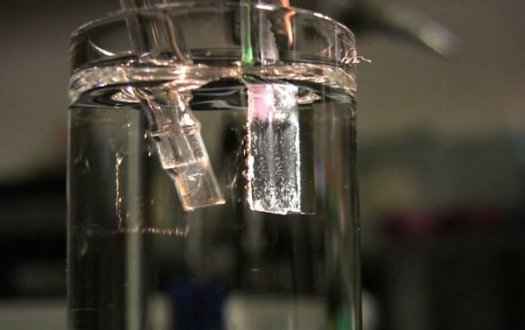Tata and MIT develop inexpensive artificial leaf; the Holy Grail of energy research

A team of researchers at MIT’s Nocera Lab, headed by Dr. Daniel Nocera, claim that they have invented a durable playing-card sized artificial leaf using inexpensive and readily available materials and technology, such as silicone and electronics – therefore making it the first practical artificial leaf technology.
 Survey
SurveyPrevious attempts at creating artificial leaves, or, man-made devices that perform photosynthesis, have been very expensive, and not durable. Nocera’s artificial leaf uses common materials, and has been successfully tested to run continuously for 45 hours without a drop in output. According to Nocera, the breakthrough came with the discovery of a cobalt catalyst that did the same job more exotic materials were trying to do.
Seen above, the first iteration of the leaf – a cobalt- and phosphate-coated silicon leaf sitting in a jar of water. Nocera claims the artificial leaf is 10 times as powerful as a natural leaf at photosynthesis, and, that this figure will go up quickly once the technology is perfected.
To be clear, the artificial leaf doesn’t actually create energy directly for consumption, but rather, uses sunlight to split water into oxygen and hydrogen, economically. For now, the two elements are then used to generate electricity in a separate fuel cell, however, in the future, an all-in-one device is possible.
While the technology has innumerable economic, political and environmental implications, it uses in developing nations is worthy of much dissemination. Nocera says that soon enough, a leaf placed in a gallon of water and left in the sun could provide a home with basic electricity for a day. Almost any type of water can be used, including waste water.
[RELATED_ARTICLE]”A practical artificial leaf has been one of the Holy Grails of science for decades. We believe we have done it. The artificial leaf shows particular promise as an inexpensive source of electricity for homes of the poor in developing countries. Our goal is to make each home its own power station. One can envision villages in India and Africa not long from now purchasing an affordable basic power system based on this technology.”
Indian giant, the Tata Group, has invested significantly in the technology, and is currently working with Daniel Nocera and his company – Sun Catalytix – to commercialize his artificial leaf. According to a company spokesman, the efforts are the company’s latest endeavour to serve the “bottom of the pyramid.”
The future of the technology is certainly impressive, with Nocera hoping to power the entire planet with a swimming pool worth of water – changed daily.
via PopSci, and Fast Company
Image courtesy: Fast Company
